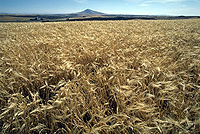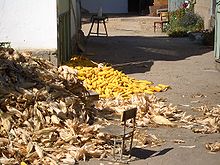- Husk
-
For the comic book superhero, see Husk (comics). For the disease affecting cattle, see Dictyocaulus. For the American film, see Husk (film).
Husk (or hull) in botany is the outer shell or coating of a seed. It often refers to the leafy outer covering of an ear of maize (corn) as it grows on the plant. Literally, a husk or hull includes the protective outer covering of a seed, fruit or vegetable. It can also refer to the exuvia of bugs or small animals left behind after moulting.
Plantago-seed mucilage is often referred to as husk, or psyllium husk.
Contents
Husking and dehulling
Husking of corn is the process of removal of its inner layers, leaving only the cob or seed rack of the corn.
Dehulling is the process of removing the hulls (or chaff) from beans and other seeds. This is sometimes done using a machine known as a huller. To prepare the seeds to have oils extracted from them, they are cleaned to remove any foreign objects. Next, the seeds have their hulls, or outer coverings, or husk, removed. There are three different types of dehulling systems that can be used to process soybeans: Hot Dehulling, Warm Dehulling and Cold Dehulling. Hot Dehulling is the system offered in areas where beans are processed directly from the field. Warm Dehulling is often used by processors who import their soybeans. Cold Dehulling is offered to plants that have existing drying and conditioning equipment, but need to add dehulling equipment to produce high protein meal. The different dehulling temperature options are for different types of production, beans and preparation equipment.
Consuming
The husk is biodegradable and should be left in a compost pile.
See also
- Chaff
- Gum (botany)
- Horsebread (a type of bread in which the chaff is not removed)
External links
Barley resources History 
Types of barley Genus: Hordeum · Cultivars: BereAgronomy Trade Parts of the plant Basic preparations As an ingredient Barley bread · Barley honey · Beer · Caffé d'orzo · Irish whiskey · Japanese whisky · Malta · Roasted barley tea · Scotch whisky · Talbina · see also: Category:Barley-based beveragesAssociated human diseases Gluten sensitivity (Coeliac disease, etc.)Related concepts Further information Wheat resources History 
Types of wheat Agronomy Trade Australian Wheat Board · Canadian Wheat Board · Corn exchange · International Wheat Council · Peak wheat · Production statistics · Protein premium · Wheat poolParts of the plant Basic preparations None: Wheatberry · Milling: Farina · Flour (types) · Groats · Middlings · Semolina · Parboiling: BulgurAs an ingredient Associated human diseases Related concepts Further information 
This botany article is a stub. You can help Wikipedia by expanding it.

